SPACE
November 07, 2023
Reuters

—
European astronomers on Tuesday released the first images from the newly launched Euclid space telescope, designed to unlock the secrets of dark matter and dark energy — hidden forces thought to make up 95% of the universe.
The European Space Agency, which leads the six-year mission with NASA as a partner, said the images were the sharpest of their kind, showcasing the telescope's ability to monitor billions of galaxies up to 10 billion light years away.
The images spanned four areas of the relatively nearby universe, including 1,000 galaxies belonging to the massive Perseus cluster just 240 million light years away, and more than 100,000 galaxies spread out in the background, ESA said.
Scientists believe vast, seemingly organized structures such as Perseus could have formed only if dark matter exists.
"We think we understand only 5% of the universe. That's the matter that we can see," ESA's science director Carole Mundell told Reuters.
"The rest of the universe we call dark because it doesn't produce light in the normal electromagnetic spectrum,” she said. “But we know its effect because we see the effect on visible matter."
Tell-tale signs of the hidden force exerted by dark matter include galaxies rotating more quickly than scientists would expect from the amount of visible matter that can be detected.
Its influence is also implicated in pulling together some of the most massive structures in the universe, such as clusters of galaxies, Mundell said.
Dark energy is even more enigmatic.
Its hypothetical existence was established only in the 1990s by studying exploding stars called supernovas, resulting in a 2011 Nobel prize shared between three U.S.-born scientists.
Thanks in part to observations from the earlier Hubble Space Telescope, they concluded that the universe was not only expanding but that the pace of expansion was accelerating — a stunning discovery attributed to the new concept of dark energy.
After initial commissioning and technical teething problems, including stray light and guidance issues, Euclid will now start piecing together a 3D map encompassing about a third of the sky to detect tiny variations attributable to the dark universe.
By gaining new insights into dark energy and matter, scientists hope to better grasp the formation and distribution of galaxies across the so-called cosmic web of the universe.
The release of the images in Darmstadt, Germany, coincided with the second of two days of European space talks in Spain dominated by Europe's continued dependency on foreign launches.
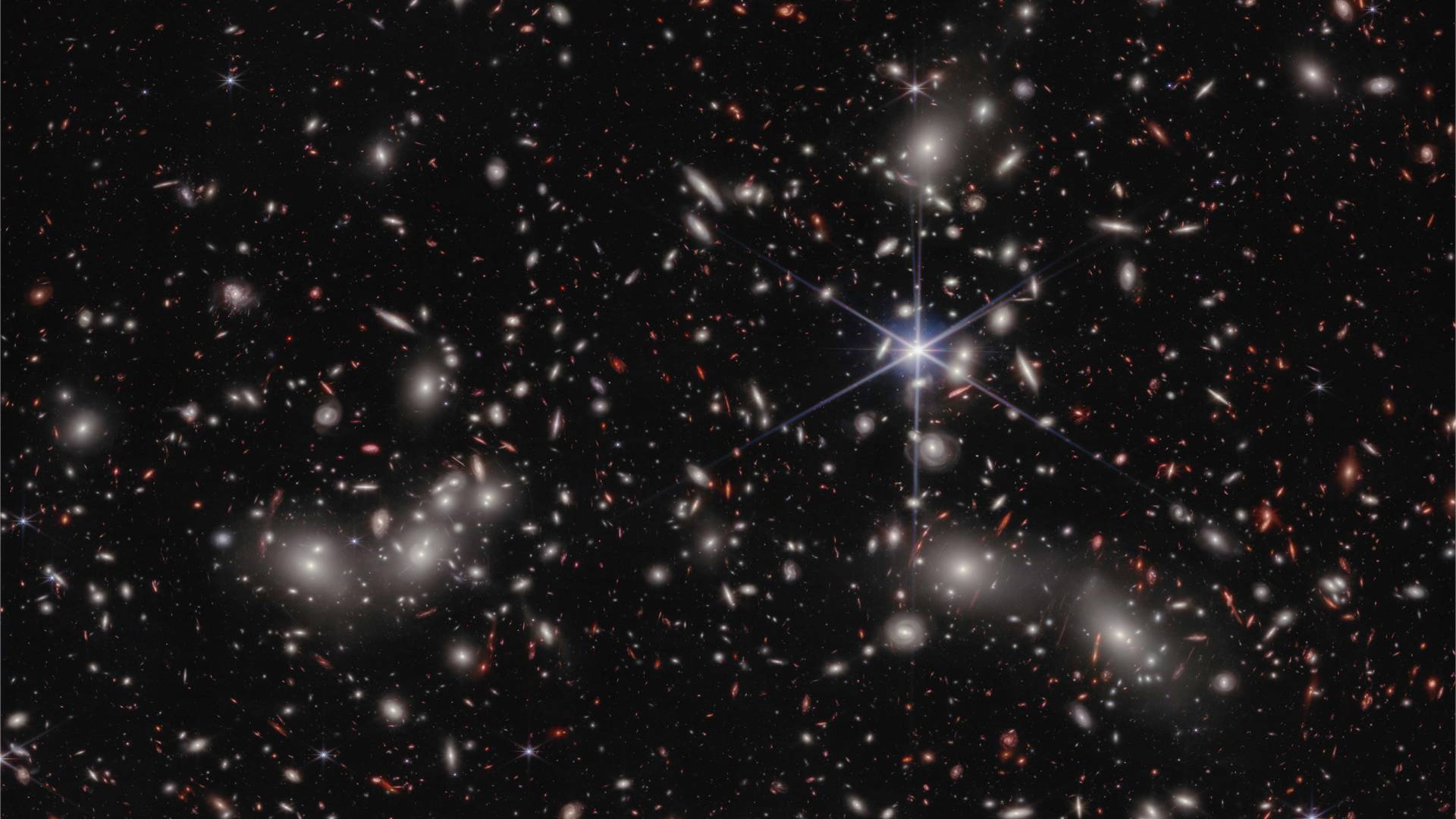
Princeton astrophysicist helps find record- smashing black hole born in the universe’s infancy
By
Liz Fuller-Wright, Office of Communications on Nov. 6, 2023,
The James Webb Space Telescope (JWST) captured this image of merging galaxy clusters; a tiny dot hidden deep in the background is a growing supermassive black hole 13.2 billion light years away.
An international team of astrophysicists including Princeton’s Andy Goulding has discovered the most distant supermassive black hole ever found, using two NASA space telescopes: the Chandra X-ray Observatory (Chandra) and the James Webb Space Telescope (JWST).
The black hole, which is an estimated 10 to 100 million times more massive than our sun, is 13.2 billion light-years away in the galaxy UHZ-1, which means the telescopes are peering back in time to when the universe was “extremely young,” Goulding said — only about 450 million years old.
“This is one of the most dramatic discoveries to come out of the James Webb Space Telescope” and the discovery of the most distant growing supermassive black hole known, said Michael Strauss, professor and chair of astrophysical sciences at Princeton, who discussed the findings with the researchers but was not part of the research team. “Indeed, it completely smashes the old record.”
Precisely how the first black holes were formed in the universe’s infancy has been a long-standing debate among astronomers.
“Now, finally discovering a black hole that was so large, when the universe was so young, tells us that the black hole must have been very large when it was initially formed, probably from the direct collapse of a massive gas cloud,” said Goulding, who is a research scientist in Princeton’s Department of Astrophysical Sciences.
It also means that astronomers can rule out other formation models, like the death of the first massive stars, because those couldn’t produce a black hole large enough to explain UHZ-1, he added.
“The black hole has only a very short time to grow,” he said. “This means that either it grew extraordinarily fast or the black hole was simply born larger.”
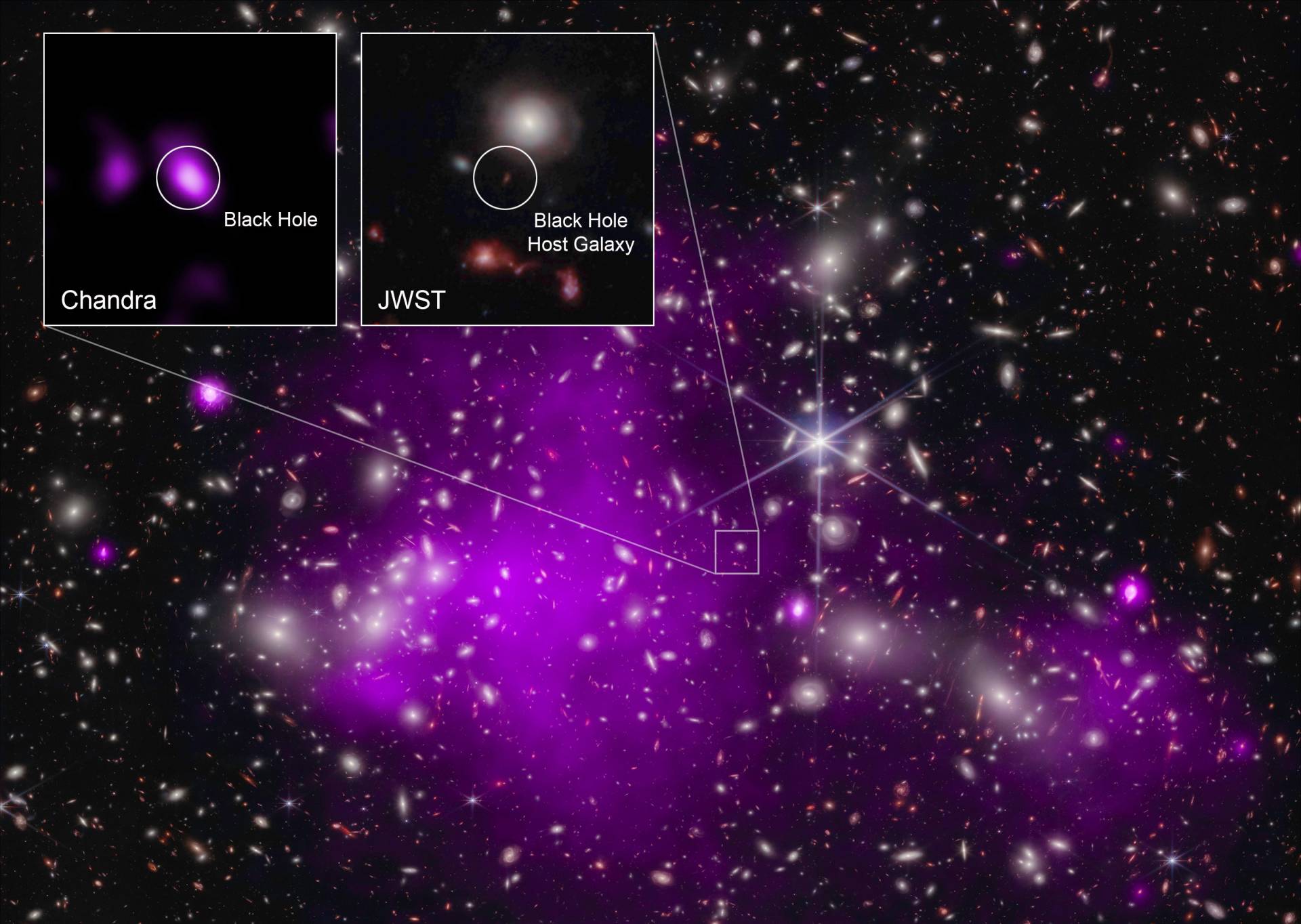
Astrophysicists combined data from JWST and the Chandra X-ray Observatory to identify the growing black hole at the center of this image.
Image by X-ray: NASA/CXC/SAO/Ákos Bogdán et al.; Infrared: NASA/ESA/CSA/STScI; Image Processing: NASA/CXC/SAO/L. Frattare, K. Arcand
Goulding is one of the lead authors of the primary paper announcing the result and the lead author of a separate paper in The Astrophysical Journal Letters detailing the mass of the galaxy and its extraordinary distance, which was pivotal to the overall result.
“Results like this show why NASA has a portfolio of elite telescopes,” Mark Clampin, director of astrophysics at NASA, said in a press release about the primary paper. “Each has their own superpowers, so to speak, and they can accomplish amazing things when they join forces.”
“We needed Webb to find this remarkably distant galaxy and Chandra to find its supermassive black hole,” said Ákos Bogdán of the Center for Astrophysics-Harvard & Smithsonian in the press release. Bogdan is first author on the Nature Astronomy paper.
NASA’s full story is available on its website.
“Evidence for heavy-seed origin of early supermassive black holes from a z ≈ 10 X-ray quasar,” appears in the Nov. 6 issue of Nature Astronomy (DOI: 10.1038/s41550-023-02111-9). Its authors are Ákos Bogdán of the Center for Astrophysics ∣ Harvard & Smithsonian (CFA), Andy D. Goulding of Princeton University, Priyamvada Natarajan of Yale University and Harvard University, Orsolya E. Kovács of Masaryk University, Grant R. Tremblay of CfA, Urmila Chadayammuri of CfA, Marta Volonteri of Sorbonne Université, CNRS, UMR 7095; Ralph P. Kraft of CfA; William R. Forman of CfA; Christine Jones of CfA; Eugene Churazov of the Max Planck Institut für Astrophysik; and Irina Zhuravleva of The University of Chicago. The research was supported by the Smithsonian Institution, CXC, NASA, the National Science Foundation /AAG, the Black Hole Initiative at Harvard University, the John Templeton Foundation, and the Gordon and Betty Moore Foundation.
“UNCOVER: The growth of the first massive black holes from JWST/NIRSpec—Spectroscopic redshift confirmation of an X-ray luminous AGN at z = 10.1,” by Andy D. Goulding, Jenny E. Greene, David J. Setton, Ivo Labbe, Rachel Bezanson, Tim B. Miller, Hakim Atek, Ákos Bogdán, Gabriel Brammer, Iryna Chemerynska, Sam E. Cutler, Pratika Dayal, Yoshinobu Fudamoto, Seiji Fujimoto, Lukas J. Furtak, Vasily Kokorev, Gourav Khullar, Joel Leja, Danilo Marchesini, Priyamvada Natarajan, Erica Nelson, Pascal A. Oesch, Richard Pan, Casey Papovich, Sedona H. Price, Pieter van Dokkum, Bingjie Wang (王冰洁), John R. Weaver, Katherine E. Whitaker, and Adi Zitrin, appears in the Sept. 20 issue of The Astrophysical Journal Letters (DOI: 10.3847/2041-8213/acf7c5). The research was supported by the National Science Foundation / AAG (1007094), the Dutch Research Council (016.VIDI.189.162, “ODIN”), the European Commission’s and University of Groningen’s co-funded Rosalind Franklin program, the Research Corporation for Scientific Advancement Cottrell Scholar Award (27587), NASA funding for JWST and Chandra, and others.
Europe to develop commercial space capsule
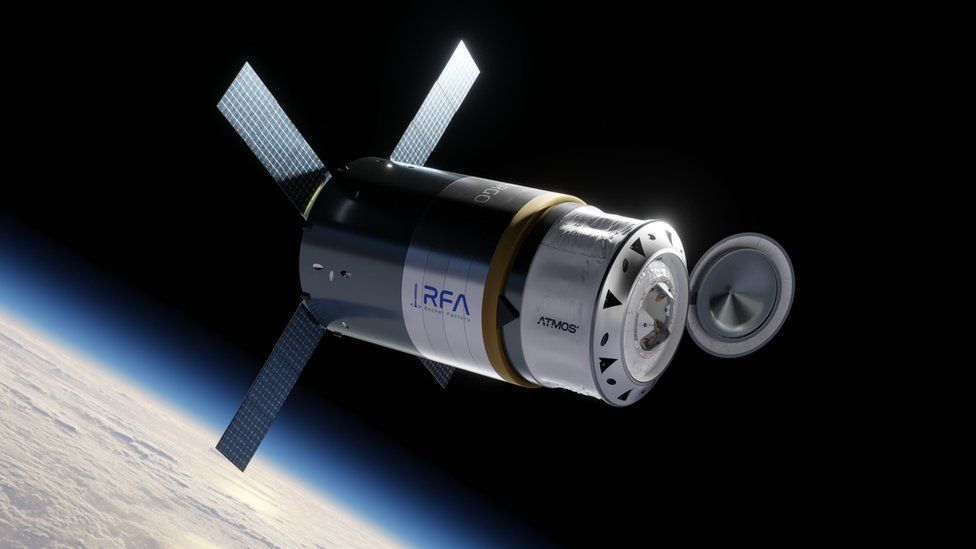 RFA
RFAA robotic capsule to carry cargo to and from the International Space Station is to be developed under a competition run by the European Space Agency.
It's anticipated the vehicle will make its maiden voyage in 2028.
The initiative marks a big shift in the way Esa has traditionally run its projects.
The competition's winner will receive some funding and technical support from the agency, but it must operate the capsule on a commercial basis.
It will have to part-fund the development and then "sell" the re-supply "service" to Esa, who will become the "anchor customer".
If the endeavour is successful, the company behind the new capsule may be asked to upgrade it so it can also carry Esa astronauts into orbit, again on the basis of a commercially contracted service.
"We will conceive [the capsule] in a way that it's not a dead end, meaning that it's open and can evolve in the future to a crew vehicle, if member states decide to do so," said Esa director-general Josef Aschbacher.
"Eventually, it could also evolve [to go to] other destinations, possibly to the Moon," he told reporters.
A tiger team was being set up inside the agency with an initial budget of €75m (£65m) to get the competition under way, the DG added.
The idea was enthusiastically backed by Esa member states at a summit in Seville, Spain, on Monday.
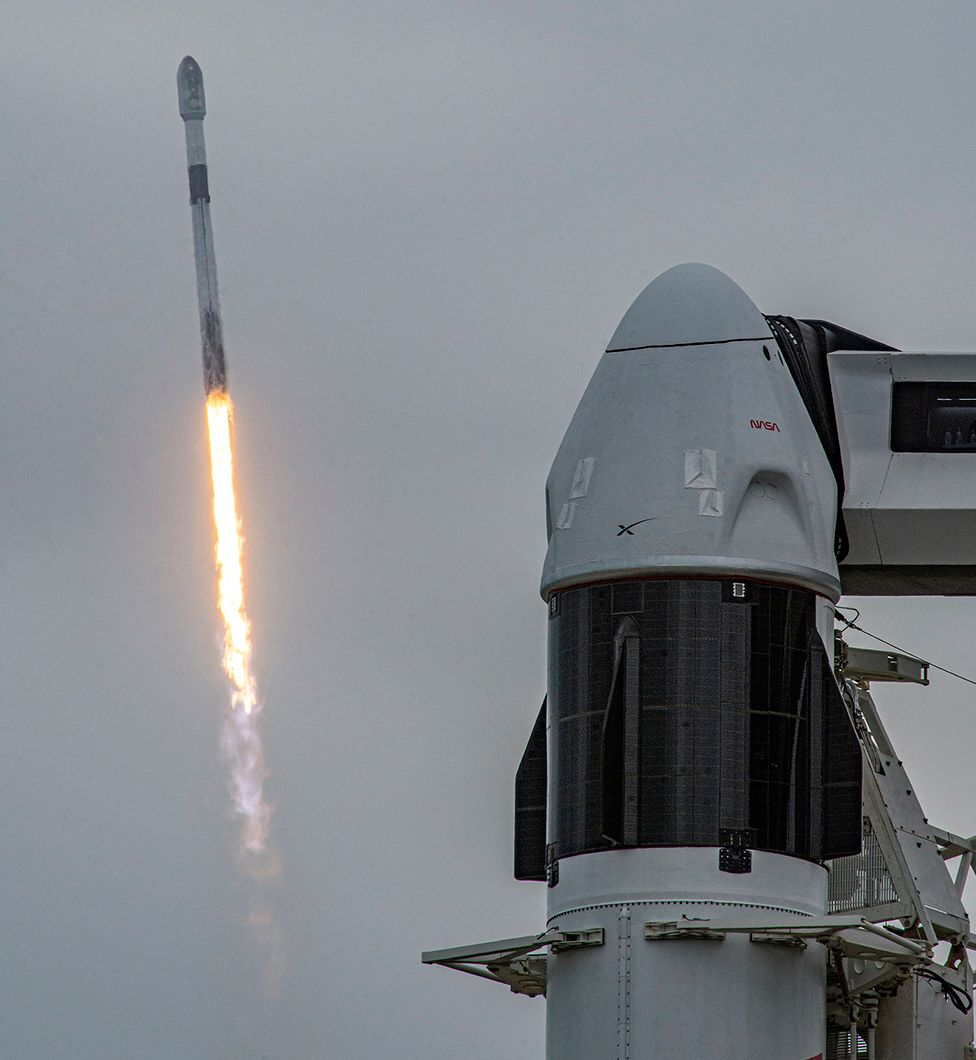 SPACEX
SPACEXThe competitive procurement model is one that has worked extremely well for the American space agency.
Nasa used to own and operate all its space vehicles. But when the famous space shuttles were retired, it opted instead to start seeding new providers, offering them fixed-price contracts and encouraging progress with milestone payments.
This is how entrepreneur Elon Musk's SpaceX company emerged. His Californian firm has since become the dominant supplier to Nasa of space transportation services. The US agency purchases seats in SpaceX capsules to get its astronauts to and from the ISS, and contracts SpaceX rockets to send science missions far beyond Earth.
The Esa competition will try to replicate this model which, in the arena of transportation, has given Nasa access to faster, more innovative and lower-cost space technologies.
Anna Christmann, a Green politician leading aerospace policy in the German government and chair of the Seville summit, said Esa was going through a paradigm shift.
"Public money is needed to start these kinds of competitions, but then that attracts investors to put money in through private companies," she commented.
"When we compare space budgets, Europe is not so different from others on the public side. The bigger difference is on the private side of investment, and that's what we want to change."
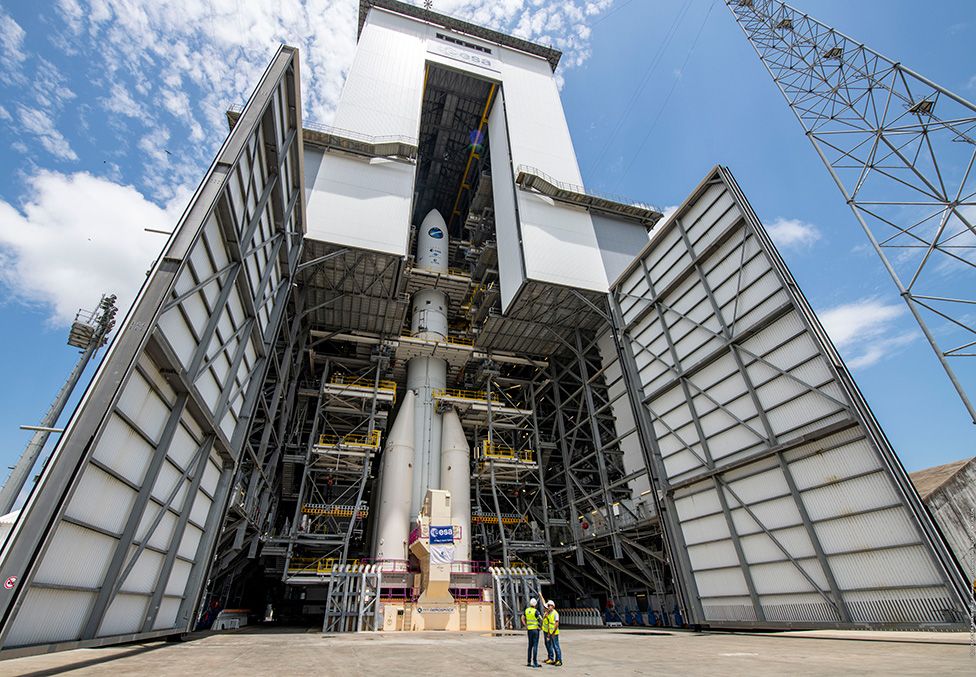 ESA/CNES/ARIANESPACE/JM GUILLON
ESA/CNES/ARIANESPACE/JM GUILLONEsa member states also committed in Seville to use the approach for procuring rockets in the long term.
Today, Europe's launchers are in crisis. The new heavy-lift Ariane-6 vehicle is years behind schedule and the medium-lift Vega-C rocket is out of action because of recent failures.
Esa member states have taken measures, at considerable cost, to try to put these projects back on track, but there is a recognition that the current malaise must not be repeated in the decades ahead.
To that end, European industry will also be challenged to provide next-generation rockets on the service model, limiting the liability of European taxpayers, who've been asked to dig deep to subsidise current hardware.
Ariane-6, for instance, will be receiving up to €340m (£295m) a year in support payments during the early phase of its exploitation.
"All 22 member states of Esa have agreed that we have to change how we procure the launchers of the future," Dr Aschbacher said.
The Seville meeting also took decisions that will see satellites play a greater role in helping European nations achieve their net-zero goals. A good example is using space data to route planes more efficiently so they contribute fewer greenhouse gases.
In addition, Esa opened its Zero Debris Charter to signatories. This encourages everyone operating in space to leave behind no hardware that might collide with operational missions.
The UK, one of the big four nations in Esa, will be promoting a new regulatory framework in the New Year that aims to promote good behaviour and even establish a market for services that remove trash from orbit.
"We want to reward compliant operators," said UK science minister George Freeman.

No comments:
Post a Comment